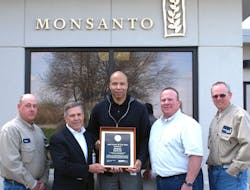Integrating the intelligent information from more than 600 HART-enabled devices into their controls systems, CMMS and daily work processes, Monsanto’s chemical manufacturing plant in Muscatine, Iowa, was able to reduce costs and improve plant operations. It also earned the Monsanto plant the 2012 HART Plant of the Year Award.
The HART Communication Foundation uses the award to showcase end users who have demonstrated ingenuity in the application of HART Communication for real-time operational improvements. In Monsanto’s case, the move to HART enabled the transition from reactive to proactive and predictive maintenance.
“By implementing condition-based monitoring techniques, we can effectively identify, diagnose, troubleshoot and ultimately repair issues prior to their effects negatively impacting production,” said Joel Holmes, Monsanto’s site electrical reliability engineer. “We were able to identify the bad actors (devices) and save the operation between $800,000 and $1.6 million in cost avoidance per year through our reliability program efforts.”
HART Communication helped the chemical plant realize benefits and savings throughout plant operations, Holmes said. It embraced the asset optimization process in assigning criticality measures to more than 14,000 pieces of equipment and instrumentation encompassing the plant. The plant also incorporated an asset management system into its site reliability workflow practices to leverage and share reliability results and document return on investment (ROI). Analyzing data enabled the plant to quantify predictive vs. reactive work by generating a “bad actor” list that shows how much “cost avoidance” the reliability program is providing.
“HART-enabled devices (measurement devices and smart valve positioners) are at the core of this achievement. I consider the asset management system to be a smart handheld on steroids!” says Holmes. “Now management is asking the reliability group to identify what we want to do next.”
Monsanto is expanding its use of HART Communication through the application of WirelessHART technology. It is currently installed at its waste treatment facility, and was recently added to one of its acetanilide herbicide manufacturing units with the addition of six level instruments for pump seal pots. Five additional WirelessHART gateways have been purchased for installation in the near future and will provide wireless network coverage for the entire facility.
Monsanto Muscatine is home to eight operating units on 150-plus acres, employing 450+ personnel. The plant produces more than 70% of North America’s Roundup Herbicide in addition to 100% of the company’s Acetanilide Select Chemistry products, including Harness Xtra, Degree Xtra and Warrant.
HART’s Plant of the Year award is given annually to recognize the people, companies and plant sites around the world using the advanced capabilities of HART Communication in real-time applications to improve operations, lower costs and increase availability. Previous recipients are Shell Scotford (Canada), MOL Danube Refinery (Hungary), Mitsubishi Chemical (Japan), Petropiar PVSDA (Venezuela), StatoilHydro (Norway), BP Canada Energy (Canada), Sasol Solvents (South Africa), BP Cooper River (USA) and Clariant (Germany), Detroit Water and Sewerage Department (USA), and Dupont (USA).

